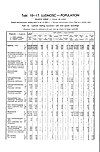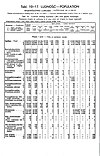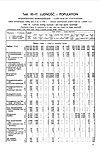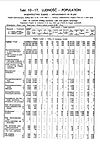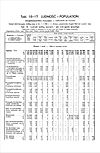1931 Polish census
| Polish census of 1931 | |
|---|---|
| Mother tongue in Poland, based on 1931 census | |
 |
The Polish census of 1931 or Second General Census in Poland (
The census was organised following the rules established by an act of the
The results of the census were being published in 39 volumes between 1936 and 1939 in a publishing series titled "Statistics of Poland". A list of all settlements in Poland was also prepared, but only a part related to Wilno Voivodeship was published.
Population by mother tongue and faith
The population was categorized by mother tongue i.e. the

| Population by first language | Population by faith | |
|---|---|---|
|
|
The number of Polish native speakers relative to the total number of Roman Catholics may be overestimated, and possibly closer 17-18 millions.[citation needed]
The population was also categorized by religion. Most Jews spoke Yiddish, and many spoke Polish and Russian. These were categorized as two groups.[5] Statistical differences existed between Ruthenians and Ukrainians. Ruthenians nationwide were 96.5% Greek Catholic but only 3.2% Orthodox, compared to Ukrainians who were almost equally divided at 52.4% Greek Catholic and 46.6% Orthodox.[4][6] Most Ruthenians lived in provinces where the majority of the Ukrainian population was Greek Catholic, too.
By cities
-
1931 Census of Poland, Miasto Kraków, table 10 Ludnosc-Population-pg.11
-
1931 Census of Poland, Miasto Łódź, table 10 Ludnosc-Population-pg.14
-
1931 Census of Poland, Miasto Lwow, table 10 Ludnosc-Population-pg.11
-
1931 Census of Poland, Miasto Poznań , table 10 Ludnosc-Population-pg.11
-
1931 Census of Poland, Miasto Warsaw, table 10 Ludnosc-Population-pg.18
-
1931 Census of Poland, Miasto Wilno, table 10 Ludnosc-Population-pg.11
By voivodships
-
1931 Census of Poland, Bialostock Voivodship, table 10 Ludnosc-Population-pg.23
-
1931 Census of Poland, Kraków Voivodship, table 10 Ludnosc-Population-pg.26
-
1931 Census of Poland, Kielce Voivodship, table 10 Ludnosc-Population-pg.28
-
1931 Census of Poland, Lublin Voivodship, table 10 Ludnosc-Population-pg.26
-
1931 Census of Poland, Łódź Voivodship, table 10 Ludnosc-Population-pg.23
-
1931 Census of Poland, Lwow Voivodship, table 10 Ludnosc-Population-pg.32
-
1931 Census of Poland, Nowogrodek Voivodship, table 10 Ludnosc-Population-pg.19
-
1931 Census of Poland, Slaskie Voivodship, table 10 Ludnosc-Population-pg.20
-
1931 Census of Poland, Polesie Voivodship, table 10 Ludnosc-Population-pg.20
-
1931 Census of Poland, Pomorski Voivodship, table 10 Ludnosc-Population-pg.26
-
1931 Census of Poland, Poznań Voivodship, table 10 Ludnosc-Population-pg.32
-
1931 Census of Poland, Stanislaw Voivodship, table 10 Ludnosc-Population-pg.22
-
1931 Census of Poland, Tarnopol Voivodship, table 10 Ludnosc-Population-pg.26
-
1931 Census of Poland, Warsaw Voivodship, table 10 Ludnosc-Population-pg.30
-
1931 Census of Poland, Wilno Voivodship, table 10 Ludnosc-Population-pg.10
-
1931 Census of Poland, Wolyn Voivodship, table 10 Ludnosc-Population-pg.22
Mother tongue controversy
The census used the concept of
Thus the number of Jews by mother tongue increased as a percentage of the population in the 1931 survey, relative to the number of Jews as a nationality in the 1921 Census.This situation created a difficulty in establishing the true number of ethnic non-Polish citizens of Poland. Some authors used the language criterion to attempt to establish the actual number of minorities, which was difficult considering that over 707,000 people in
Some authors contend that the change in questions asked by the census officials was due to the Polish government's wish to minimise the presence of minorities[3][13][14] and represented an attempt to maximize the effects of a decade of educational policies stressing the Polish language.[15] Tadeusz Piotrowski called the 1931 census official but "unreliable" for determining ethnicity, saying that by using language as an indicator of ethnicity it had underestimated the number of ethnic non-Poles, and that in particular, ethnic Poles were not a majority in the Nowogródek Voivodeship and Polesie Voivodeship.[16] A 1954 study of the Polish population by the United States Census Bureau concluded that "in presenting the results, the Central Statistical office emphasized the central role played by the Polish ethnic group by increasing the number of minority groups, and thus reducing the size of a given group, shown in the results. Ukrainian and Ruthenian were tabulated as separate languages, although Ukrainian was simply the newer name for Ruthenian, used by the more politically conscious and nationalistic elements. In the Province of Polesie, the census authorities returned most of the Belarusians there as speaking 'local languages'."[5]
After World War II the pre-war chairman of the Polish census statistical office Edward Szturm de Sztrem was quoted by communist sources to have admitted that the returned census forms had been interfered with by the executive. This it was claimed, affected particularly those forms from the south-eastern provinces. The extent of the tampering is not known.[17] Another English language account stated that he admitted "that officials had been directed to undercount minorities, especially those in the eastern provinces".[18]
References
- Główny Urząd Statystyczny(1932). Drugi powszechny spis ludności z dnia 9 XII 1931r. Formularze i instrukcje spisowe (in Polish). Warsaw: Główny Urząd Statystyczny. p. 128.
- Council of Ministers of the Republic of Poland (1931). Rozporządzenie Rady Ministrów z dnia 2 września 1931 r. w sprawie przeprowadzenia drugiego powszechnego spisu ludności (PDF) (in Polish). Warsaw. Dz.U. 1931 nr 80 poz. 629.)
{{cite book}}: CS1 maint: location missing publisher (link - ^ ISBN 978-90-279-3239-6. Retrieved 17 October 2015.
- ^ a b "Główny Urząd Statystyczny Rzeczypospolitej Polskiej, drugi powszechny spis ludności z dn. 9.XII 1931 r. - Mieszkania i gospodarstwa domowe ludność" [Central Statistical Office the Polish Republic, the second census dated 9.XII 1931 - Abodes and household populace] (PDF) (in Polish). Central Statistical office of the Polish Republic. 1938. Archived from the original (PDF, direct download, table: page 30) on 2014-03-17.
- ^ a b US Census Bureau, The Population of Poland Ed. W. Parker Mauldin, Washington-1954. pp.74-75
- ^ a b (Polish) Główny Urząd Statystyczny (corporate author) (1932) "Ludnosc, Ludnosc wedlug wyznania i plci oraz jezyka ojczystego" (table 10, pg. 15)
- ISBN 0-8143-2494-0. Retrieved 17 October 2015.
- ISBN 0253204186.
- ISBN 0253204186.
- ISBN 978-0-333-79256-8. Retrieved 17 October 2015.
- ^ Jerzy Tomaszewski (1985). Rzeczpospolita wielu narodów (in Polish). Warsaw: Czytelnik. p. 35., as cited in Piotrowski, op.cit., page 294
- ^ Henryk Zieliński (1983). Historia Polski 1914-1939 (in Polish). Wrocław: Ossolineum.
- ISBN 978-0-7864-0371-4. Retrieved 17 October 2015.
- ISBN 978-0-7425-1094-4. Retrieved 17 October 2015.
- ISBN 978-0-521-57697-0. Retrieved 17 October 2015.
- ^ Piotrowski, op.cit., page 143: [The Belarusians] were distributed as follows: Polesie, 654,000; Nowogrodek, 616,000; Wilno, 409,000; Bialystok,269,100
- ^ Joseph Marcus (1983), p. 17;
- ISBN 0-8131-3041-7. Retrieved 17 October 2015.
External links
 Media related to Polish census of 1931 at Wikimedia Commons
Media related to Polish census of 1931 at Wikimedia Commons- Original report from census. Document is in Polish and French. Internet Archive (PDF file direct download, 88 pages).
- The Podlaska Digital Library: document search. Partial results can be found when searching for the following keyword: Spis powszechny 1931 r


